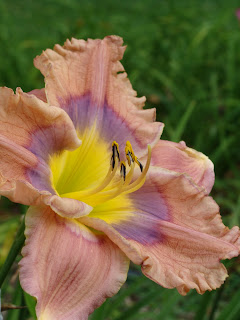Click on any of the photos to enlarge and enjoy!
This summer 250 daylily fanatics went to Wadsworth, Ohio to attend the Region 2 Summer Meeting and were treated to a weekend to remember. From the handmade goodie bags, to the well organized plant sale, to the smiling faces at registration, to the fabulous live auction, to the great food, the great gardens and the wonderful people - we had it all. We voted for the Englerth Award winning seedling, we shopped in a cool boutique, and we were inspired by the daylily in all the tour gardens.
Seen on the left is H. 'Art in Heaven' by the bird-loving, expertly- purple Ludlow Lambertson. It was the most stunning daylily I saw during the two days of tours around north central Ohio and it is certainly high on my wish list. If they can grow it down there, Im going to take a chance on it here in Michigan - if I could only find a piece for sale!
What I remember most about these gardens were the wonderfully planned vignettes and thoughtful color-coordinated plantings. So many of the gardens had collages of containers, as seen below at Fran Houghtlen's garden. Notice even the hanging basket complements the container collage. She sure knows how to put a scene together; they were all over her garden.
H. 'Big Kiss' seen on the left below was a stunning clump. Look how tall those scapes are, and notice how full the flowers are...now notice how the scapes arent bending at all! They are standing tall and putting on quite a show. Love it. I tried H. 'Big Kiss,' but it died twice for me here in Zone 5. Must have been me, though, several of my friends in the area grow it just fine. Sigh.
.JPG)



Above left the crocosmia was simply the most fabulous thing ever in the Burkey's garden. It danced in the wind and splashed a gorgeous color of red in the wicked long fence planting at their home. I thought it looked like a hundred red hummingbirds. Awesomeness.
H. 'Dreamsicle Supreme' from Nicole Harry was a close runner-up for favorite bloom seen on tour. I couldn't order this one fast enough straight from Nicole when I came home from Regional. It has settled in nicely since being planted in August. I cannot wait to see this one and all its 7" glory next summer.
You know I never go anywhere without talking about the food. Oh, the food. I love tour food. I love to see what people choose to serve their guests, how they serve it, and how the guests enjoy it. The people who serve the food in tour gardens are always the coolest people to talk to...they are usually moms, sisters, best friends, or neighbors who are pitching in however they can to make sure their loved ones day is a success. At Wendy Schwall's, we learned that her grandmothers made the deee-lishhhh-ous shortbread cookies. The grandmothers were enjoying the tour from prime rocking chair seats on the front porch. Many folks approached them to send their compliments to the chef.
The walking tacos at Sally Marcum's were so clever and well done and very tasty - great flavor. And again, cool people serving them with great care. Our bus actually broke down for a short bit at Sally's and I didnt really mind much, since I knew there were scads of walking tacos to be eaten in her back yard. These finger treats were at Wendy Schwall's. I think I ate all six of these after I took the photo. Sorry - they were seriously fresh and full of homegrown goodness.

I saw H. 'Maymont Double' for the first time at Sara Knackstedt's Daylilies By The Pond. I loved the full, creamy shape of this double. The color was clear and just looking at it I was refreshed - it reminded me of frozen lemonade...or fresh whipped cream. Yummy.
Yes, as seen below I also took time to enjoy a few laughs on a very cool swing at the Burkey's. Many folks took a moment to sit a spell here and laugh. It was nice to see people from all ages enjoy this treat. I remember the swing at Jeff and Elizabeth Gilbert's last summer in Illinois and the gorgeous pergola swing at the Seago's in Georgia. I love swings outside.
I loved these gardens on tour. They all had places to sit, great snacks, cold drinks, and above all else - wonderfully grown and exhibited daylilies. Below are more daylilies I saw for the first time.
H. 'Hologram' and H. 'Memphis'
H. 'Yazoo Double Butterscotch' and H. 'Purple Kaboom'
H. 'Purple Kaboom' may be the "grapiest" daylily I have ever seen. Like Violet Beauregarde purple- you know the kind I mean. Purple in every sense of the word.
So many breathtaking daylilies and so little time to see them all in one short, sweet summer. Thanks, ODS.
The Southern Michigan Daylily Society is the host for the 2011 Summer Meeting. The dates are July 15-17, 2011 and the hotel will be the Detroit-Troy Marriott in Troy, Michigan. Please plan to join us!




.JPG)
.JPG)





.JPG)
.JPG)











.JPG)
.JPG)




.JPG)




